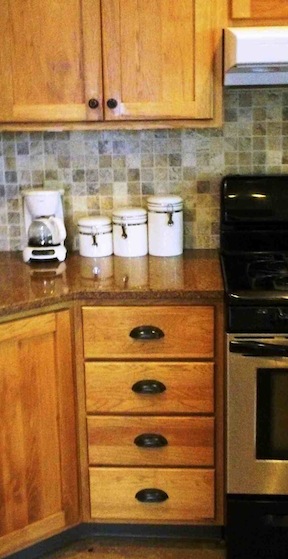 Patricia K. Townsend – NYIPL Board Member
Patricia K. Townsend – NYIPL Board Member
(Continued from Part 1)
As I mentioned in last month’s column, when building our new kitchen our principle #1 was: Investigate all the materials. Principle #2 was Buy things made as close to home as possible.
Investigating where things were made turned me into a detective and a devotee of googling. I became obsessed with finding unfinished wood bar stools that we could paint with bright colors, in the 24” height suitable for our new island. I believe that we may now own the last two such stools made in the United States. I found them in the basement of a store in Rochester, New York. The manufacturer of one was a company in the Adirondacks that went out of business. The Oregon manufacturer of the other has now started to sell stools made in Vietnam out of timber shipped from Oregon!
Principle #3 was Minimize energy use.
We left the decisions about insulation to the experts but we were actively involved in the search for lighting, most of which is now made in China. (There goes Principle #2 again.)
We are happy with our tankless hot water heater, which quickly makes enough hot water for a houseful of guests to shower but doesn’t keep a tank of water hot when we are away from home.
We used a Kill A Watt meter to monitor electricity use. That helped us decide that we should replace our 35-year-old working freezer with a new one. Careful analysis showed us that the new freezer that needs defrosting is more energy efficient than a frost-free model with the Energy Star label. Thirty-five years of experience in defrosting the old one taught me that the task is easy and gets me into a routine of sorting things out to make sure that I haven’t overlooked any of last year’s crop of strawberries or green beans.
Principle #4 was ReUse and Recycle.
We moved the appliances from the old kitchen if they passed the energy-efficiency test. We also saved money when our contractor let my husband Bill salvage the cedar siding and shingles from the old north wall that is now an inside wall for the carpenters to use on part of the new construction. Bill is a master at re-using– building a spiral herb garden and a patio from brick salvaged from the old chimney.
We enjoy cooking and eating in the new kitchen, especially when the produce is from our own backyard vegetable and herb garden. We don’t have any chickens in the back yard (yet), though we’ve found a farmer who sells us free-range chickens to keep in that energy-efficient freezer.
